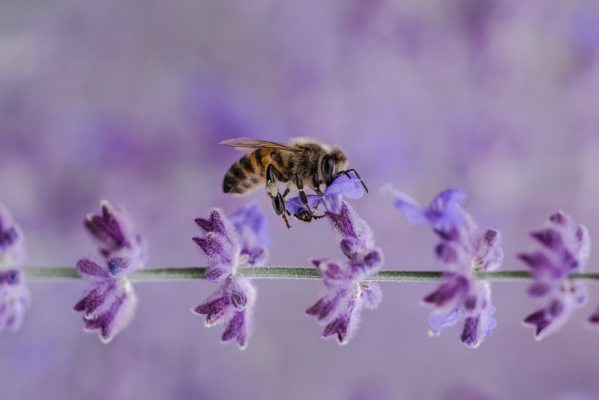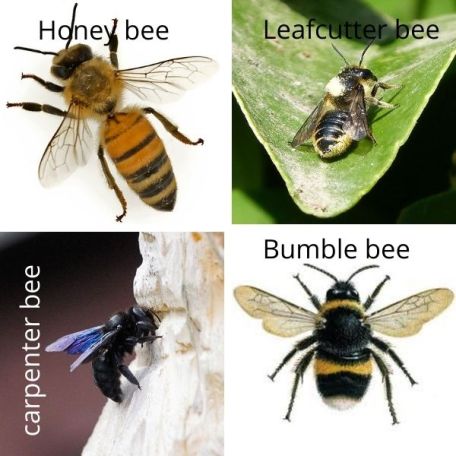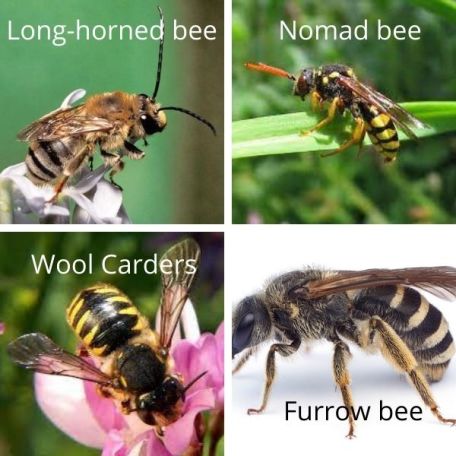Before we dive into this vast topic, let me tell you what you can expect to learn about:
- Different types of bees
- 9 species of bees and their characteristics
- 7 families of bees
So, let’s begin.
Which species do honey bees fall under? The genus Apis.
This bee species has at least 44 known sub-varieties.
We know that bees share traits like honey and wax comb production and living with a queen in a colony. But, they’re still marked by unique characteristics you’ll be interested to learn.

What are the types of bees?
The world of bees is MASSIVE! There are over 4000 different genera (aka types) of bees.
Out of these 4000, you would be familiar with these common types of bees:
- Honey bees (Family: Apis)
Popularly known as the social bees, the honey bee family lives in colonies that consist of at least 50,000 workers.
Honey bees normally nest in tree trunks and caves, but sometimes they also nest in chimneys.
Without honey bees, we wouldn’t have food on our plates. They are extensively used in cross pollination.
If you’re hoping to dig a little deeper and learn about how bees pollinate, this article might help!
2. Bumble bees (Family: Apidae)
These bees are excellent flower pollinators.
Most bumble bee colonies that you see will have around 200 bees. Although most are social, there are also the cuckoo bumble bees which are of the parasite species and take over the nests of the bumblebee hosts.
Speaking of these cuckoo bumble bees… they’re a bunch of tricksters! Here’s what I found out about them.
3. Leafcutter bees (Family: Megachilidae)
Rightly termed, these bees cut out segments of leaves with the help of their jaws. With these leaf segments, they construct their egg cells.

4. Mason bees (Family: Megachilidae)
Belonging to the bee genus Osnia, Mason bees use their scent to mark their nest entrances.
They often make nests in crevices, empty snail shells, and sometimes in old mortar.
5. Mining bees (Family: Andrenidae)
As the name suggests, digger bees or mining bees are known to excavate tunnels and underground cells.
These solitary bees belong to the largest families of the genera of bees, and are important to the pollination of blueberries, cranberries, and other key crops.
6. Large carpenter bees (Family: Apidae)
Belonging to the bee genus Xylocopa, the large carpenter bees are known to make their nest by chewing tunnels into wood.
7. Plasterer bees (Family: Colletidae)
Commonly known as cellophane or polyester bees, these plasterer bees create and line their nests with a waterproof substance.
8. Wool Carders (Family: Megachilidae)
These types of bees make their nests by collecting hairs from plants and rolling them into a ball.
Many bees belonging to this species can be easily mistaken for wasps. This is because they too are marked by yellow and black body colors.

9. Flower bees (Family: Apidae)
Flower bees are able to buzz pollinate and are often observed foraging in early spring. They belong to the bee genus Anthophora which means ‘flower bearer’.
10. Nomad bees (Family: Apidae)
Often mistaken for small wasps, the nomad bees are known to attack the nests of bees from the Colletes, Andrena genus, Eucera, and many others.
11. Long-horned bees (Family: Apidae)
Belonging to the genus Eucera, which means ‘well-horned’, these long-horned bees are characterized by their long antennae.
12. Furrow bees (Family: Halictidae)
Having a distinctive striped appearance, the furrow bees are gatherers or collectors. They are often seen foraging on wildflowers such as thistles and knapweed.
9 different species of bees and their characteristics
Now that you’re familiar with the different types of bees, here are the different species of bees:
- Apis Mellifera: The European or Western honey bee
This is the bee species you might have seen more often.
Marked by yellow stripes on their abdomen, the Apis Mellifera bee species is known for their large colony size. They’re usually found living in dead, hallowed trees.
Because they’ve been domesticated for the past 5000 years, this bee species has started to exhibit qualities that benefit humans; they prioritize climate hardiness and honey production.
Below are the subspecies of Apis Mellifera.
- Apis Mellifera Mellifera: The German or dark honey bee species
This bee species appears stocky, small and ranges in colors from black to brown.
Since this bee species are natives of Germany, UK, and Scandinavia, they are well accustomed to the cold weather.
- Apis Mellifera Carnica: The Carneolan or grey honey bee species
Due to the great amount of hair they have on their body, this species appears to be grey in color.
This species is gentle, so beekeepers don’t face problems while taking care of them. However, they do tend to swarm around in spring, so one might have to watch out for that.
- Apis Mellifera Ligustica: The bee species from Italy
Being natives of Italy, this subspecies is better accustomed to warm weather.
The Apis Mellifera Linguistica are a gentle bee species that are known for their industrious production of honey, bee eggs, and wax.
A drawback to owning these bees is their robbing habit. Additionally, they’re also known to eat their own honey supplies if there’s a shortage of pollinating plants.
- Apis Mellifera Caucasica: Caucasian honey bee species
Similar to the Carnolean honey bee species, the Apis Mellifera Caucasica species is hairy and can appear grey.
This species is generally considered to be slow in building their colony. They’re also mild in their temperament.
- Apis Mellifera Iberiensis: The Iberian or Gibraltar honey bee species
These are tiny bees that are of the most unusual variety.
An interesting feature of this species is that they’re extremely pure. This means that they only mate with Queens that have their own genetics.
One more interesting fact about them is that they’re incredibly defensive. In the sense that, if they’ve been intruded upon, they send out a group of bees to aggressively attack anything in their surroundings. It’s their defense technique.
- Apis Mellifera Scutellata: The honey bee species from Africa
Also known as “African killer bees”, this species rose to fame (not in a good way) because a group of scientists in Africa allowed them to escape.
They had been cross-bred with some European varieties of bees when this happened, causing them to show unusual, dominant behaviors (such as executing Queens belonging to other colonies!).
I was particularly intrigued by this bee family and so I did some research. Here’s an article that might interest you as well.
Some other honey bee species (aka other varieties of Apis) are as follows:
These are less regularly kept by beekeepers but are still interesting to learn about!
- Apis Cerana: Eastern or Asiatic or Himalayan honey bee
These types of bees are smaller in size and do not produce a lot of honey. For this reason, a big number of this bee variety has been imported by beekeepers in Northern India. This region consisted of diseases that spread to the bees. (Curious to learn about this disease? I found this article that could give you some insight.)
The apis variety has therefore coexisted with these diseases for several years. This has also made the bees more resilient. It has caused the bees to adapt better behaviors to deal with tough situations.
Another interesting fact about this bee variety is that it is extremely hygienic. Because of this, it can clear and renew the wax of brood combs and protect bee larvae from pathogens.
Two more things.
The Apis Cerena species is highly adaptable to temperature changes.
And, they can defend themselves against predators by surrounding them in a tight cluster and vibrating their wing muscles so intensely that the heat generated from this activity will burn the predator to death!
- Apis Dorsata: Giant honey bee
Like the name suggests, this bee variety is giant in size. They cannot be domesticated in enclosed places or hives.
The only way to harvest these bees is to climb to great heights until you reach their colony, and cut off their combs. They’re an aggressive bunch, so watch out!
So how many species of bees are there? Just 9? Nope, there are around 30,000 bee species in the world. But we’re just going to learn about this for now.
7 families of bees
Currently, there are 7 recognized families of bees, which are:
- Apidae
This is the largest family of bees.
The Apidae bee family includes bumble bees, honey bees, South America’s stingless, honey-producing bees, carpenter bees, digger bees, orchid bees, and cuckoo bees.
- Megachilidae
This bee family is a solitary one. The bees belonging to this family are robust and have large heads and mandibles.
The Megachilidae family includes leafcutter bees, mason bees, carder bees, and two groups of cuckoo bees.
Some interesting facts:
- Instead of carrying pollen on their hind legs, like other bees, they carry it under their abdomen.
- The bees from this family have diverse nesting habits. They use building materials like mud, wood pulp, gravel, leaf pulp, and plant fibers.
- The biggest bee in the world is the Megachile pluto which lives in Indonesia, inside active termite mounds.
Just like you, I’m a bee nerd too. So, I thought you might like to learn a little more about the Megachilidae family.
3. Halictidae
Also known as sweat bees, (because they have the habit of lapping up sweat by landing on people!)The Halictidae family usually consists of tiny bees.
While some bees in this family resemble honey bees, most are difficult to identify.
Nomia melanderi, the alkali bee, is the only ground-nesting, solitary bee that is commercially managed for crop pollination. They are metallic blue-green in color and are the most beautiful-looking Halictidae.
4. Andrenidae
If you’ve seen bees in early spring, they’re probably from the Andrenidae family. Because they’re most commonly seen during this season.
Bees belonging to this family are of medium size. They have tan to reddish hair along their thorax and sometimes the abdomen as well. Some bees also have intricate patterns. Some others may also resemble wasps or bumble bees.
5. Colletidae
This family of bees is also known as “cellophane bees” or “plasterer bees”. Wonder why?
It’s because they use plastic to keep water out and line their nests.
Bees belonging to this family often resemble mining bees. Other bees in the family include crepuscular bees and yellow-faced bees in the genus Hylaeus.
6. Melittidae
Melittidae is a small, solitary, family of ground-nesting bees.
Bees belonging to this family are usually black in color, small, and may or may not have abdominal hair.
In the genus Macropis, there are the oil bees that collect floral oil instead of pollen. (to feed their baby bees)
7. Stenotritidae
Found only in Australia, Stenotritidae is the smallest family of bees.
They are closely related to the Colletidae, and are hairy, large, black & yellow striped, black, or metallic green.
In conclusion,
Identifying different kinds of bees is hard because there are WAY too many species, families, and genera of bees.
But I hope you now have a clearer understanding of where they come from, what they look like, and what their distinctive traits are.
Read here: